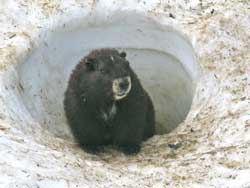But the fact that the majority of those pups were born in one region on Vancouver Island also tells us there is important work left to do. Increasing the marmots’ distribution across more of their historic range is a vital part of the recovery strategy to protect them.
So it’s also very good news that the marmots are making progress in more of their historic range as well. Three of the litters born this year were on mountains that have not had recorded breeding on them in over a decade. Two of the sites were extinct much longer than that.
A successful litter on Castlecrag Mountain in Strathcona Park is particularly encouraging because of its proximity to Mount Washington. As the only continuously surviving colony north of Alberni Inlet, the Mount Washington colony had been showing negative signs of inbreeding before captive-born recruits were introduced there as part of the Recovery Strategy.
Castlecrag is one of a handful of nearby fledgling colonies that, once reestablished, would provide a natural recruitment of wild-born marmots to guard against the risk factors of an isolated population. That would be a huge step forward for the marmots in this region.
There are now ten fledgling sites in Mount Washington/Strathcona Park area where marmots are struggling to establish breeding pairs and rebuild the colonies. It will take a few more years of artificial recruitment, by way of organized releases, to establish enough marmots in this region for natural dispersal processes to take over.
Whether the marmots make it or not is largely up to us Canadians. Although we have rescued them from the imminent threat of extinction, they are not yet able to complete their recovery on their own. But if we can continue to support them for another few years it’s highly likely they will reach the final Recovery Goal – a sustainable population distributed in three distinct regions on Vancouver Island. For information about how you can help the Vancouver Island marmots go to www.marmots.org
